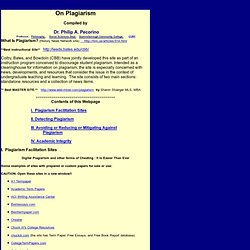Pada dasarnya, ini adalah Ini adalah Bunyi Bel 3 Bahasa dalam Format Mp3 yang nantinya bisa anda download dan anda gunakan untuk melengkapi nada bel pergantian pelajaran. Download Kumpulan Nada Bel Sekolah 3 bahasa. Tiga bahasa disini maksudnya adalah, Bunyi Bel Sekolah Bahasa Indonesia, Nada Bel Sekolah Bahasa Inggris dan Bahasa Arab. Bunyi bel skolah teeewet mp3 download. Sekarang saya akan share Suara atau Bunyi Bel Sekolah Otomatis Kurikulum 2013 untuk aplikasi bel sekolah. Berikut beberapa suara ringtone bel sekolah MP3: Nada Bel Sekolah Lengkap - Full Day School (Klik Gambar Untuk Memperbesar). Menyambung posting Download Bel Otomatis Sekolah dan Cara Penggunaanya (Gratis). Bell Sekolah Otomatis adalah.
The best ever free plagiarism detection software is here. Clean your content. CEBE - Plagiarism detection with CopyCatch Gold. Text Analysis.
Copycat is a model of analogy making and human cognition based on the concept of the parallel terraced scan, developed in 1988 by Douglas Hofstadter, Melanie Mitchell, and others at the Center for Research on Concepts and Cognition, Indiana University Bloomington.[1] The original Copycat was written in Common Lisp and is bitrotten (as it relies on now-outdated graphics libraries for Lucid Common Lisp); however, Java and Python ports exist. The latest version in 2018 is a Python3 port by Lucas Saldyt and J. Alan Brogan.
- 2Comparison to other cognitive architectures
Description[edit]
Copycat produces answers to such problems as 'abc is to abd as ijk is to what?' (abc:abd :: ijk:?). Hofstadter and Mitchell consider analogy making as the core of high-level cognition, or high-level perception, as Hofstadter calls it, basic to recognition and categorization.High-level perception emerges from the spreading activity of many independent processes, called codelets, running in parallel, competing or cooperating. They create and destroy temporary perceptual constructs, probabilistically trying out variations to eventually produce an answer. The codelets rely on an associative network, slipnet, built on pre-programmed concepts and their associations (a long-term memory). The changing activation levels of the concepts make a conceptual overlap with neighboring concepts.
Copycat's architecture is tripartite, consisting of a slipnet, a working area (also called workspace, similar to blackboard systems), and the coderack (with the codelets). The slipnet is a network composed of nodes, which represent permanent concepts, and weighted links, which are relations, between them. It differs from traditional semantic networks, since the effective weight associated with a particular link may vary through time according to the activation level of specific concepts (nodes). The codelets build structures in the working area and modify activations in the slipnet accordingly (bottom-up processes), and the current state of slipnet determines probabilistically which codelets must be run (top-down influences).
Comparison to other cognitive architectures[edit]

Copycat differs considerably in many respects from other cognitive architectures such as ACT-R, Soar, DUAL, Psi, or subsumption architectures.
I will just Windows key + RUN (type Downloads which is my folder). If you downloads folder is full of stuff, you can try searching Kies3Setup to find the setup quicker. Samsung kies lite for windows 7 10. Simply run the setup.
Copycat is Hofstadter's most popular model. Other models presented by Hofstadter et al. are similar in architecture, but different in the so-called microdomain, their application, e.g. Letter Spirit, etc.
Since the 1995 book Fluid Concepts and Creative Analogies describing the work of the Fluid Analogies Research Group (FARG) book, work on Copycat-like models has continued: as of 2008 the latest models are Phaeaco (a Bongard problem solver), SeqSee (number sequence extrapolation), George (geometric exploration), and Musicat (a melodic expectation model). The architecture is known as the 'FARGitecture' and current implementations use a variety of modern languages including C# and Java. A future FARG goal is to build a single generic FARGitecture software framework to facilitate experimentation.
See also[edit]
References[edit]
- ^Hofstadter, Douglas R.Fluid Concepts and Creative Analogies. ISBN978-0-465-05154-0.
Further reading[edit]

- Mitchell, Melanie. Analogy-Making as Perception. ISBN0-262-13289-3. (1993)
- Hofstadter, Douglas R.Fluid Concepts and Creative Analogies. ISBN978-0-465-05154-0.
External links[edit]
- The Copycat Project: A Model of Mental Fluidity and Analogy-Making (pdf)
- Abhijit Mahabal's Seqsee code in Perl and in Python